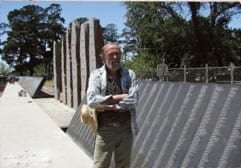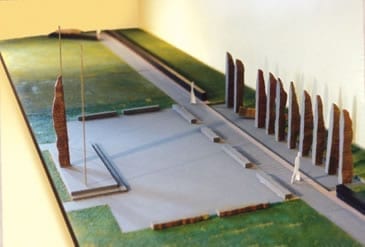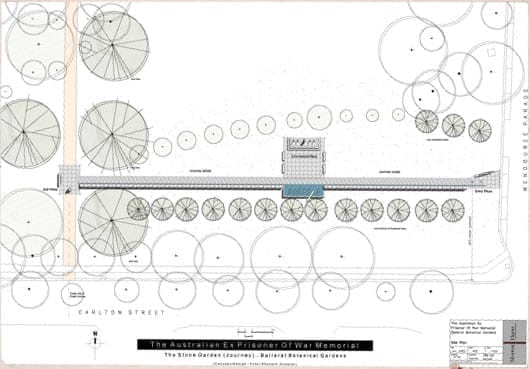Materials Used: Natural Stone-Basalt and Granite
Cost: $1.8 million for commission and construction of Memorial and the etching of 35,000 names on 130 metre long granite wall.

Peter Blizzard is a well-respected sculptor both in Australia and overseas. He has exhibited internationally, designed public works in both Melbourne and Sydney and has been commissioned to undertake major sculptural projects for the Australian Government and the Catholic Church.
Between 1972 and 1995 Peter Blizzard was lecturer, senior lecturer and Head of School in sculpture at the University of Ballarat.
Peter Blizzard is a very spiritual person and his sculptures deeply reflect how he feels about the effect that man has on the environment.
Sadly, Peter Blizzard passed away on the 6th January 2010, however he has left us all with a lasting legacy, his works can be seen and enjoyed in many countries and they are a testament to his skill.
The Australian Ex-Prisoners of War memorial visually challenges the visitor by its sheer size, it takes the visitor on a journey similar to journeys undertaken by all Australians who embarked for war away from their homeland and loved ones.
Peter explains the concept of the Memorials symbolism below as a “Stone Garden Journey”:

This memorial to Australian Prisoners of War takes the observer on a journey, more than 36,000 Australian men and women were held captive as prisoners by the enemy during the Boer War, World War 1, World War 2 and the Korean War. This memorial honours them. There were no Australian Prisoners of War in the Vietnam War.
The journey begins on a long pathway designed to create a strong visual perspective that emphasizes the great distance Australians traveled to war. The paving stones forming a pathway are shaped like railway sleepers in recognition of the iconic place of railway journeys in the history of Australian Prisoners of War.
A roll of names of all known Australian Prisoners of War is etched into a black granite wall lying parallel to the pathway. The roll gives no rank, number or enlistment detail. In recognition that sacrifice, suffering and desperation acknowledged no person’s status. These men and women are equals.
In a break in the wall a row of stone obelisks stands sentinel in a shallow pool of water. Each bears the names of countries where Australians were held as Prisoners of War. The obelisks are out of reach across the water, symbolizing that all the prison camps were overseas, far from home and the comfort of family and friends. The size of each obelisks and their position in the water creates a powerful image and offers a place for reverence and reflection.
The roll of names on the granite wall continues towards a large stone at the end of the pathway. The stone rests on a small granitite wall and bears the timeless instruction ‘Lest We Forget’. This is the end of the journey – an intimate space for contemplation.
Water springs from beneath the ‘Lest We Forget’ stone then flows down the wall into the narrow watercourse in front of the first group of names and into the reflective pool, then continues past the second group of names. Finally it disappears under the pathway, returning to its source under the ‘Lest We Forget’ stone to start the journey again.
Water symbolizes the essential nature of man, sacrifice, suffering, spirituality, healing, cleansing, birth and re-birth. In this memorial it forms a continuous cycle, binding all Australian Prisoners of War together for all time.
The memorial is created from natural materials and is designed to be in harmony with the Ballarat Botanical Gardens, and to create a sense of timeless, dignity and respect.

